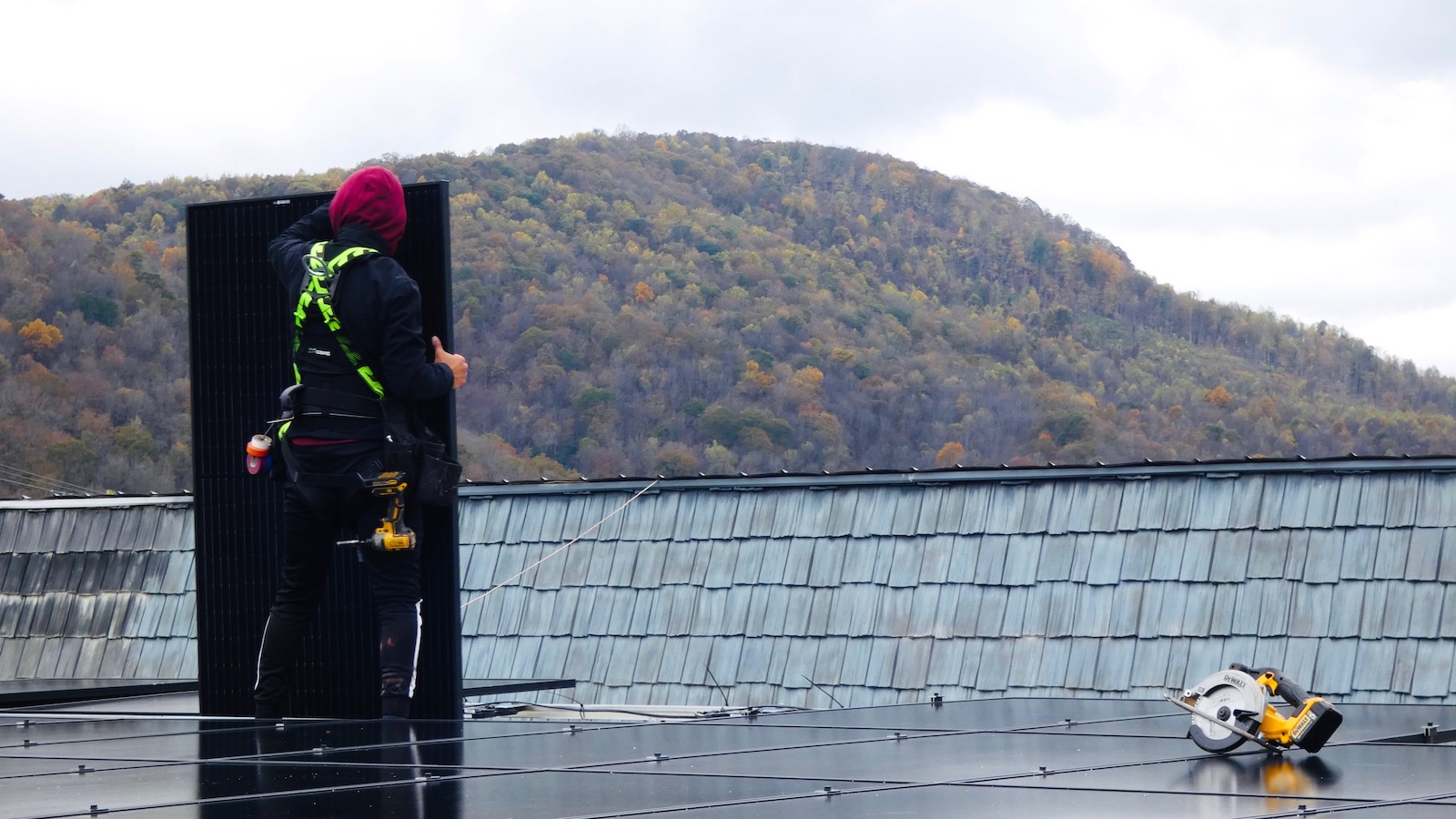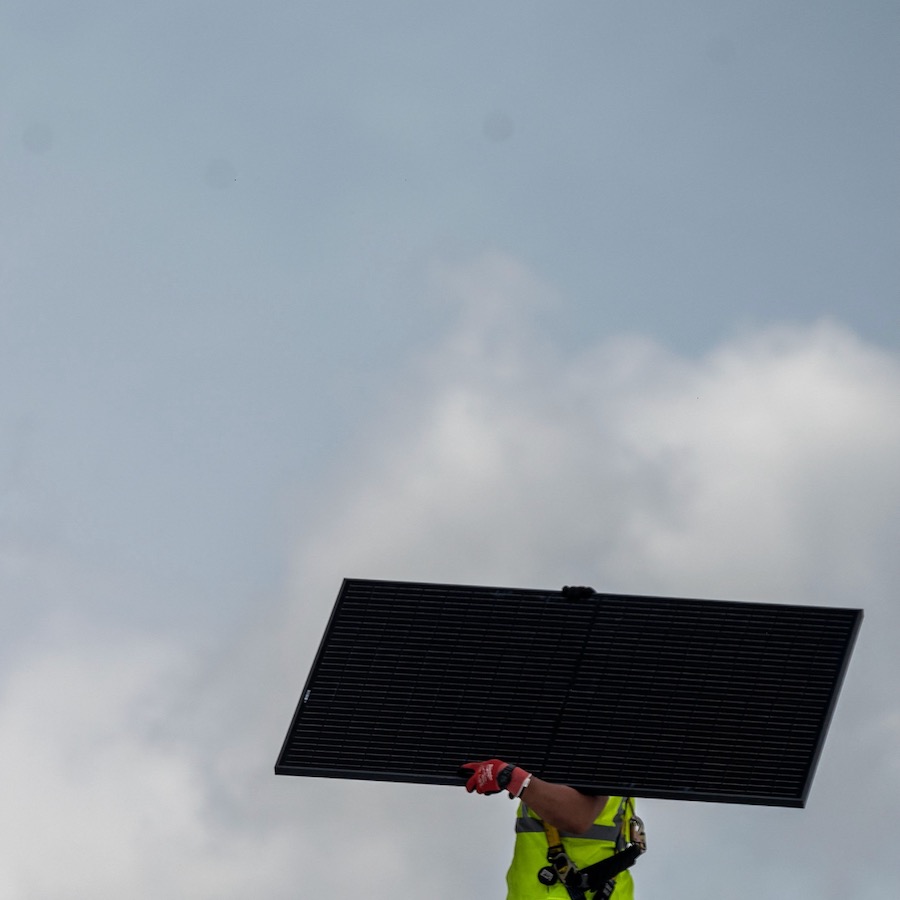When Matt McFadden came of age in southwestern Virginia in the early 2000s, he wasn’t planning on working for a clean energy outfit. He grew up playing in a high school garage band, part of his increasingly Republican county’s small punk scene. But staring out at the photovoltaic panels gleaming atop his daughter’s elementary school in July — an array his company, Secure Solar Futures, installed — he was beaming with pride. In the midst of the Inflation Reduction Act’s rollout, McFadden and coal-rich Wise County have something many politically conservative areas from Texas to Ohio are struggling to create: Real, and growing, support for solar.
McFadden and his firm have not accomplished this alone. In 2016, a coalition of businesses, nonprofits, colleges, local governments, and citizens launched the Solar Workgroup of Southwest Virginia, which collaborates with Secure Solar Futures. It includes experts in every aspect of the green transition, from community organizers who tell neighbors about the benefits of solar to legal experts who propose legislation. The organization was heavily involved in the deal to install arrays on 12 schools in Lee and Wise counties and brought the idea to the attention of the Appalachian Solar Finance Fund, which, along with some state funding, financed part of the ongoing project.
Wise County is one of seven coal-producing counties in southwestern Virginia, and the rock has been pulled from the surrounding hills since 1880. In 2021, a panel that advises President Biden named the region the nation’s fourth most coal-dependent economy and said it should be prioritized when considering grants to remedy environmental damage and create union jobs. McFadden said provisions in the IRA that provide tax credits for projects in low-income and coal communities, coupled with those that reward using domestically manufactured components, allow his company to save up to 60 percent on an installation — savings that it passes on to customers.
Such factors have made this solar energy’s time to shine in southwestern Virginia. According to a 2017 report from consultants at Downstream Strategies, projected installations of commercial, residential, and utility-scale arrays could generate 2,163 permanent and temporary jobs in the region by 2028. That may not seem like much compared to how many the coal industry employed at its peak, but advocates see solar as one part of a diversified regional economy.
“I know this is the future. I know this is where we need to go,” McFadden said. “And it’s going to help create jobs.”

The enduring cultural importance of coal in central Appalachian communities has long been a hot topic inside and outside of the region, particularly after President Trump made “bringing coal back” a talking point during his 2016 campaign. Much airtime has been dedicated to asking why so many voters seek the return of an industry in decline. Virginia’s miners produced 10.2 million tons of the fossil fuel in 2022, down from a peak of 46.6 million in 1990. Outsiders often see this trend, driven in large part by declining prices for renewables and natural gas, alongside hesitancy about solar and ask, “Well, what’s wrong with them?” said Emma Kelly, who leads the Workgroup’s community outreach.
“I’m from the coalfields,” Kelly, who grew up in eastern Kentucky and now lives in southwestern Virginia, said. “And you have to understand. Coal mining is not just a job. The coal industry is not just an employer. It’s not like Walmart. [Coal companies] built towns, they built schools, they built churches, they made their own money. You cannot really overestimate the amount of domination they had over these social and economic systems.”
Because residents of southwest Virginia may see solar as helping accelerate the loss of coal jobs, she and McFadden consider their being locals an important component of building confidence in, and support for, the technology.
McFadden grew up in Wise County and is raising a family there. He joined Secure Solar Futures in 2020 after a brief stint in the “hustle and bustle” of Charlottesville, Virginia while working for a home electrical wiring company. He returned home after realizing that “all the money I [was] helping make and all the stuff I [was] doing is not coming back to my economy.” While Secure Solar Futures is headquartered northwest of the coalfields in Staunton, Virginia, Matt is based in its growing Wise office. People trust him to oversee the work on their kids’ schools because if he makes a mistake “it’s my name in the mud.” Anyone with complaints knows where to find him.
More important, though, is the fact local solar advocates and companies like Secure Solar Futures make it clear that their mission goes beyond profit. “I don’t get anything out of this except a sense of fulfillment,” said Kelly, who became involved in solar advocacy in 2022 after learning, to her surprise, of solar’s potential in the coalfields.
“If you are from around here, people know that you know the history, people know that you know the land, she added. “And so people assume that you will be a lot more cognizant about not being extractive, not exploiting the community and not contributing to a lot of the already existing issues.”
She’s alluding to mining’s environmental and health impacts. The industry’s automation and decline — resulting in widespread layoffs that require just two months notice — left residents with a gutted economy, polluted water, and respiratory diseases, not to mention deep mistrust of interlopers. Coalfield communities are primed to consider solar developers outsiders looking to use them and the land without creating self-sustaining communities. For many in central Appalachia, decades of exploitation of both their labor and resources with little long-term investment in workforce health has created the expectation that lofty economic promises leave behind devastation. Misinformation, often linked to the fossil fuel industry, about clean energy also is to blame for some of the local skepticism, as are prior negative experiences with government-led programs and initiatives.
As Kelly put it, “It’s very much a sense that ‘Oh, we were sold coal. We were told that coal is great, and now look what it’s done. Now here you are trying to tell us there’s this magic energy source, and it’s so amazing. [But] what does that mean for us in 20 years?’”
Given the region’s history, Kelly and other solar advocates in southwestern Virginia said being local, proving solar’s benefits, and building a coalition have been key to ensuring the technology’s success in the face of cultural and political opposition. In the year since the passage of the IRA, which provides roughly $370 billion in tax credits and grants to support the green energy transition, clean power advocates in other “red” counties have found similar success with that approach.

In the coalfield community of Whitesburg, Kentucky, just over the state line from Wise County, a solar pavilion and rooftop at the arts education center Appalshop has attracted curious neighbors, said Kathleen Byrne, the center’s development director. Until last year’s historic floods took part of the system offline, the project helped Whitesburg’s beloved “anchor institution” stabilize its energy costs rather than face Kentucky Power’s rate hikes. Byrne said she has sensed people’s interest in renewable energy because “it would help them in their bottom line when they’re paying their bills every month.”
The increased interest Byrne senses may be manifesting across the area. Autumn Long, program director of Appalachian Solar Finance Fund, has said the group — which was created only two years ago and serves six states — is receiving applications for solar project funding and technical assistance from a “wide range of entities,” including churches and fire stations.
If the Inflation Reduction Act has been a boon to local solar advocates, McFadden says state policy, historically friendlier to southwest Virginia’s utilities than customers, remains a roadblock. Until the Virginia Clean Economy Act took effect in July, 2020, public entities like school districts could not go solar without paying the hefty upfront cost of the photovoltaic array and operating it themselves. Provisions in the law made it possible for them to enter an arrangement called a power purchase agreement with solar installers, allowing schools to buy energy from the array they host without owning it — though they can choose to buy it when the deal ends.
Yet, Governor Glenn Youngkin has been pushing to downplay solar and wind and add more nuclear to the state’s energy mix instead. Given that the nation’s first small modular nuclear reactor is not expected to become operational until 2029, clean energy advocates wonder why Youngkin would push the technology when southwestern Virginia abounds with former strip mine sites suitable for hosting solar now. Wise County is already home to the first solar project in the state to be built on such land, a large array providing the Mineral Gap Data Center with as much as 3.6 megawatts, or enough energy to power roughly 622 homes.
Youngkin’s 2022 energy plan states that the plan his predecessors adopted “goes too far in establishing rigid and inflexible rules” for the state’s energy transition. Those rules include a mandate in the Virginia Clean Energy Act directing the state’s two major utilities, American Electric Power and Dominion Energy, to achieve 100% renewable generation by 2045 and 2050, respectively. Nuclear energy, unlike solar, would be controlled by utilities, which may explain their embrace of Youngkin’s enthusiasm. Typically, Virginia’s major utilities have fought efforts to expand consumer-generated energy like power purchase agreements and shared solar without prohibitive fees or caps.
Meanwhile, solar advocates hope small victories will help them scale up. McFadden said demonstrating the technology’s feasibility through community-focused projects like the 12 school installations his company is handling has changed perceptions in the area. McFadden said arrays on the seven schools in Wise County alone (six of which are complete) are expected to save the district $60,000 in the first year, a sum expected to increase as rate hikes from traditional utilities continue. Unless a customer insists, his company refuses projects that are not estimated to reduce energy costs in the first year. “I’m not going to try to sell someone on negative net equity,” McFadden said.
Hiring locals to install and maintain the photovoltaic panels is key, too. In 2022, Secure Solar Futures started an annual apprenticeship program that trains local high schoolers to do everything from wiring arrays to the physical heavywork of carrying and arranging panels and pays them $17 an hour. This tangible example of a solar operation employing community members has been part of “the proof in the pudding.”
“When a lot of parents and grandparents saw that there were benefits for their children,” he said, “thought processes changed.”
Hannah Wilson-Black is an environmental journalist and 2023 Pulitzer Center Reporting Fellow based in Huntington, West Virginia. Her work has appeared in Terrain.org, The Appalachian Voice, and The Daily Yonder.

